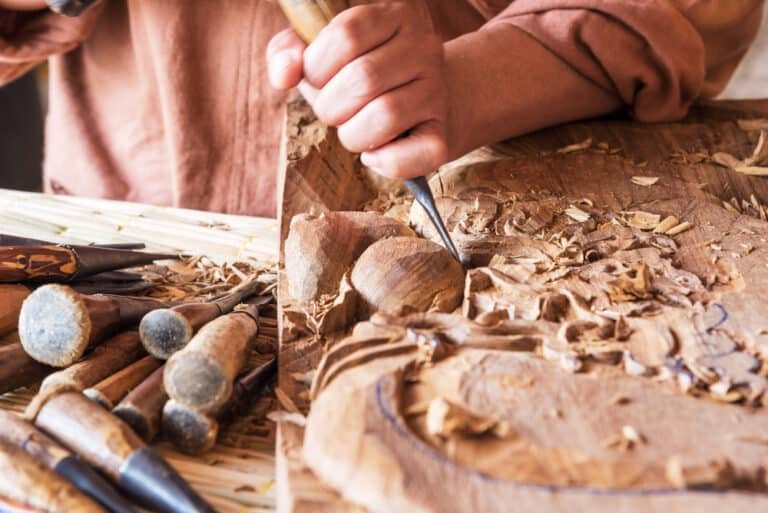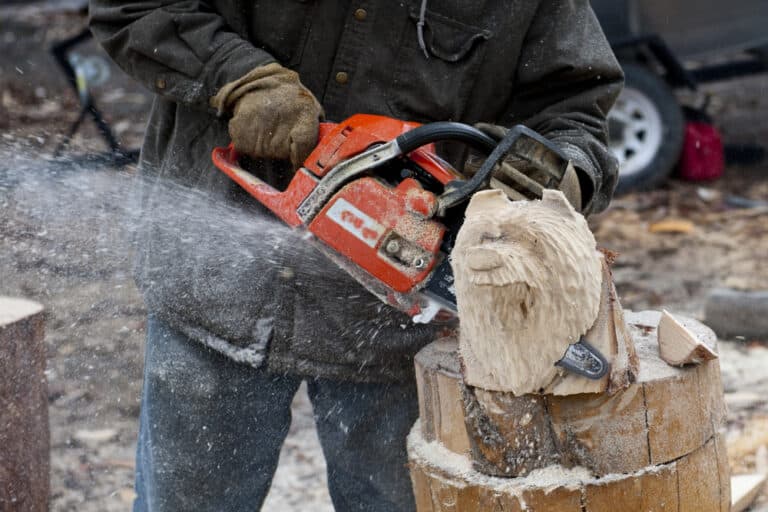
Green wood, known for its natural moisture content, can be the perfect choice for wood carvers looking for a versatile material to work with. But working with green wood can come with its own set of challenges, the primary one being the potential for cracking or splitting as it dries.
Fear not; preventing these imperfections is entirely possible with a few helpful tips and techniques. By properly sealing, storing, and drying your green wood, you will not only ensure the durability of your finished projects but also maintain the beauty of your carvings.
Throughout this article, we’ll explore different methods to keep your green wood from splitting, so you can focus on the creative journey and enjoy the rewards of working with this beautiful and natural material.
Controlling Moisture Loss
Controlling moisture loss is crucial to prevent green wood from splitting. One way to do this is by ensuring even drying to avoid creating uneven tension within the wood. You can control the drying process by wrapping your green wood in a plastic bag or cloth to slow down the evaporation.
Be sure to avoid direct sunlight while drying, as this can cause rapid moisture loss and induce splitting. Maintaining proper temperature and ventilation in your drying area is essential.
Proper Storage and Drying Techniques
Kiln-drying is useful for achieving an even drying environment, but it can be difficult without the proper setup. In this case, use alternative methods like air drying.
Storing the wood in a cool, dry place with good airflow helps prevent splitting and cracking. Stacking the wood with spacers between the layers, ensuring they are level, and placing a weight on the top layer can all contribute to even drying and minimize splitting.
Sealants and Coatings
Pentacryl
Pentacryl is a wood stabilizer designed to displace water in greenwood, effectively reducing the chances of cracking and splitting.
Boiled Linseed Oil
Boiled linseed oil is a popular choice for sealing green wood and preventing it from splitting. It’s easy to apply and works well for wood carvers. To use boiled linseed oil, follow these steps:
- Sand the wood surface lightly, moving with the wood fibers.
- Apply a generous amount of boiled linseed oil to a clean cloth or brush.
- Rub the oil onto the wood surface, making sure to cover all exposed areas.
- Wipe off any excess oil and let it dry for at least 24 hours.
You may need to apply additional coats for optimum protection.
Anchorseal
Anchorseal is another option to consider when looking for a sealant to prevent green wood from splitting. It’s a wax-based product that provides a barrier against moisture loss, protecting your wood from drying too quickly and cracking. To apply Anchorseal, follow these steps:
- Stir the product well before use.
- Brush or roll a generous coat onto the exposed surfaces, especially the end grain.
- Allow Anchorseal to dry for at least 24 hours.
Polyurethane Varnish
Polyurethane varnish is a widely used sealant for protecting wood from splitting. Its durability and waterproof quality make it ideal for wood carvers. To apply polyurethane varnish, proceed as follows:
- Sand the wood surface to prepare it for the varnish.
- Apply a thin layer of polyurethane varnish with a brush, ensuring even coverage.
- Allow the first coat to dry for at least 4-6 hours.
- Sand the surface lightly and remove any dust.
- Apply additional coats, letting it dry and sanding between each one.
Paintable Wax
Paintable wax is another option to consider when seeking a sealant for preventing splitting in green wood. Applied similarly to Anchorseal, paintable wax provides a protective barrier on the wood’s surface. To use paintable wax, follow these steps:
- Apply a generous amount of wax to a clean cloth or brush.
- Rub the wax onto the wood surface, covering all exposed areas.
- Wipe off any excess wax and let it dry before carving.
Wood Glue and Epoxy
Wood glue and epoxy can also be used to seal green wood and prevent splitting. Mixing wood glue with sawdust to create a paste that can be applied to the exposed grain areas is possible. On the other hand, epoxy is best suited for small cracks and voids that need filling. Here’s how to use these sealants:
- For wood glue, mix equal parts glue and sawdust to create a paste. Apply it to the end grain areas and allow it to dry.
- For epoxy, mix the two-component epoxy according to the manufacturer’s instructions. Fill in small cracks and voids with the mixed epoxy, and let it cure as directed.
Using one of these sealants and coatings can effectively protect your green wood from splitting, ensuring successful wood carving projects.
Salt Solutions and Pastes
A salt solution or salt paste can be applied to green wood to help prevent splitting. Soaking the wood in a salt solution or applying a salt paste can create a barrier against excess moisture while maintaining a consistent drying rate. This helps in preventing the wood from splitting due to rapid moisture loss.
To make a salt solution, mix 1-part salt with 10-parts water. Soak the green wood in the solution for 24 hours and then allow it to air dry. For a salt paste, mix equal parts salt and water and apply the paste directly to the wood surface. Allow it to dry completely before proceeding with carving.
Cornstarch and Eggs
Cornstarch and eggs can also be used as natural sealants, helping to prevent the wood from splitting or cracking as it dries. This method is especially useful in humid environments, where mold and fungus growth is a concern.
To create a cornstarch sealant, mix equal parts cornstarch and water, and apply it to the wood surface with a brush. If using eggs, separate the egg whites from the yolks, and apply only the egg whites to the wood surface with a brush. Both of these methods should be allowed to dry completely before carving commences.
Causes of Wood Splitting
Understanding the reasons behind wood splitting is crucial.
Uneven Drying Process
Green wood has a high moisture content, and as it dries, its volume will significantly reduce. This results in a phenomenon called “cutting checks,” which are the small cracks that form due to wood’s uneven drying.
Wood Grain
Wood grain refers to the arrangement of wood fibers throughout a log. Select wood with consistent, straight grain patterns, as they are less likely to have internal stress that can lead to splitting.
Fiber Direction
When wood fibers run parallel to the grain direction, the wood is less likely to split. Therefore, you should:
- Choose wood pieces with straight fibers that run along the length of the wood.
- Be cautious when working on areas with twisted or interlocked fibers, as they are more prone to splitting.
- Employ techniques like using a sharp carving tool and working with the grain to avoid putting excessive stress on the wood fibers.
Final Thoughts
Understanding the factors contributing to wood splitting can improve your carving skills and help you create better-quality projects. Keep in mind the drying process, wood grain, and fiber direction. Apply preventive measures like sealing ends and controlling humidity; and choose high-quality materials to ensure your wood carvings stay beautiful and intact for a long time.



